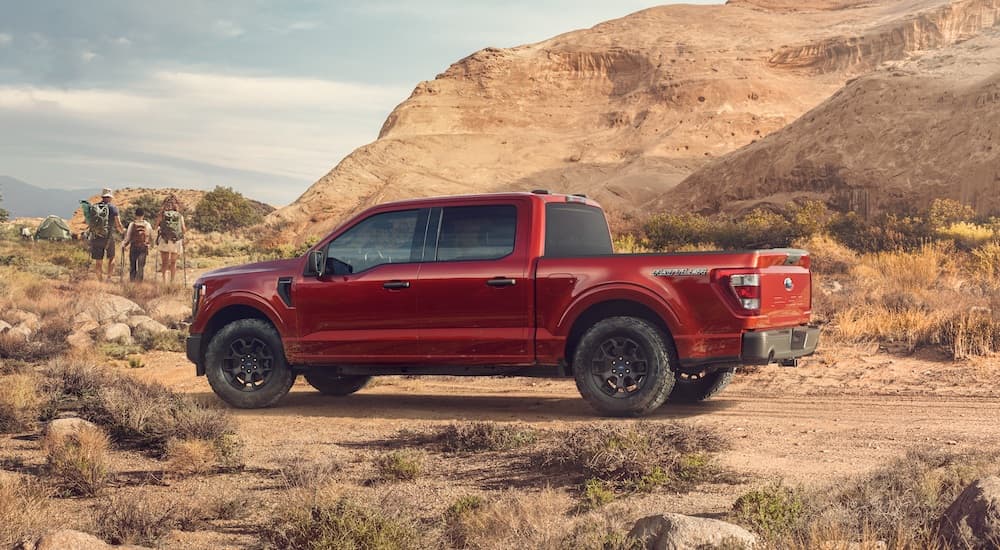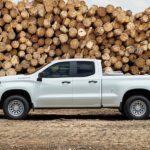If there’s a rivalry more competitive than the one between Ford and Chevy, we’re certainly unaware of it. From the earliest days of the automobile and the advent of mass production to the golden age of the muscle car when supremacy on the blacktop was waged between the Mustang and Camaro, all the way up to today, Chevy and Ford have been in constant competition. In recent years, both manufacturers have spent a great amount of time placing emphasis on their fleets of SUVs, but it’s the pickup truck that has remained a flagship product for both brands.
Consumers have long pondered the subject of which offering is better. Ford, with their F-150, or Chevy, with their Silverado 1500? While much of this debate is subjective, we offer a different type of comparison. Before we begin the contest of the 2023 Chevy Silverado 1500 vs 2023 Ford F-150, we wish to make our intentions clear—this is taking an extra special look at the powertrains and how the different options stack up against one another.
Base Offerings That Are Anything but Basic
Every journey begins with a single step, and in the case of our comparison, it all starts with what both Ford and Chevy provide as the base offering for their respective vehicles. Of the four different engines that are associated with the 2023 Chevy Silverado 1500, the base offering is certainly an impressive one. A turbocharged 2.7L four-cylinder engine propels the Silverado forward with the benefit of 310 horsepower and the ability to generate 430 lb-ft of torque. This engine is paired with an eight-speed automatic transmission and allows more than adequate towing capabilities with a maximum rating of 9,500 lbs.
Ford, on the other hand, doesn’t have anything smaller than a V6, and that’s what they have to offer for their base offering. The powertrains for the F-150 start with a 3.3L V6. While still offering considerable power courtesy of 290 horsepower, it falls short of the 310 hp offered by Chevy. Every engine that’s equipped with the Ford F-150 is paired with a ten-speed automatic transmission for optimum performance. However, Chevy’s base offering can out-tow Ford’s, as the V6 can only pull up to 8,200 lbs.
Diesel Power vs Hybrid Efficiency
A common phrase regarding nostalgia is “what once was old is new again.” When it comes to the diesel-fueled engine, this is certainly the case. The past several years have seen GM revitalize the concept of diesel fuel and put it to work to provide potency at low RPMs and conservative fuel consumption. Indeed, GM’s Duramax line of engines is impressive. Ford eliminated its diesel powertrain during the 2021 model year. So, we’ll be comparing the Silverado’s 3.0L Duramax Turbo-Diesel I-6 engine against Ford’s 3.5L PowerBoost Turbo Hybrid V6.
Ford’s 3.5L V6 Powerboost Engine certainly pushes the limitations of what a hybrid powertrain is capable of. With gasoline and electrical power working together in unison, the PowerBoost is impressive in every sense of the word. Providing the F-150 with 430 horsepower and granting the ability to generate 570 lb-ft of torque, it also allows the versatile workhorse to pull an astonishing 12,700 lbs maximum. Equally as impressive is the fuel economy that the mighty V6 has to offer. 25 MPG in the city and 25 MPG on the highway is above and beyond expectations. With such impressive numbers and innovation, one might be wondering if the diesel-fueled Duramax comes close to the same level of performance and capability as Ford’s hybrid V6. Well, let’s see how it stacks up.
The Duramax turbo-diesel takes the form of an inline six-cylinder and is equipped with GM’s ten-speed Allison transmission for ideal performance when it matters most. Pushing out 305 horsepower and generating an impressive 495 lb-ft of torque, it accomplishes these tasks while operating at low RPMs. And while the towing capabilities of Ford’s hybrid V6 are quite impressive, the Chevy outclasses Ford with a maximum towing capacity that reaches up to 13,300 lbs. Perhaps even more remarkable is the superior fuel economy that diesel offers. With 24 MPG in the city and 29 MPG on the highway, the Diesel engine is simply a more economical choice in terms of fuel consumption.
Firing on Five Liters and Eight Cylinders
As we look towards the mighty V8 engine and all of its capabilities, we’re gauging the specs from two motors that are in the five-liter range. First up is Chevy’s EcoTec3 5.3L V8. Boasting a maximum towing capacity of 11,300 lbs, it’s been one of the most reliable workhorses in Chevy’s arsenal for quite some time. With 355 horsepower and the capability to belt out 383 lb-ft of torque, it handles its own and delivers the goods.
Facing off against one of Chevy’s V8 offerings is a grizzled veteran who’s long been regarded as one of the cornerstones of the Ford. Known affectionately as the “Coyote,” the 5.0L V8 has earned its stripes more than once as a reliable engine that Ford fans can always count on. The Coyote outclasses Chevy in the performance department, with the capability to push out 400 horsepower and generate 410 lb-ft of torque. Towing prowess also goes to Ford the time around, with a capacity of up to 13,000 lbs which outshines its long-time rival.
Top of the Line in Towing
As we reach the end of our comparison, we look at the top towers that each truck has to offer. This is where high-end horsepower and towing prowess come into play. So, if there are those among you who need to carry heavy loads and move mountains, this information will be quite beneficial.
When it comes to offering towing prowess, Chevy’s top draw is actually a tie between two of its engines. The 6.2L V8, which boasts an impressive ability to tow up to 13,300 lbs, is identical to the Duramax engine. And while the diesel option still outclasses the V8 in the ability to generate 495 lb-ft of torque in comparison to the V8’s 460 lb-ft, it pales in horsepower. (The Duramax diesel has 305 hp while the 6.2L V8 has 420 hp.)
Ford’s 3.5L twin-turbocharged V6 outclasses Chevy’s offering in terms of pulling more. When properly equipped, Ford’s V6 has a maximum towing rating of 14,000 lbs, which is well above the maximum from Chevy. It also matches the Coyote V8 with 400 horsepower, a rating that falls just short of the offering from Chevy. However, when it comes to the generation of torque, the turbocharged V6 outperforms Chevy’s big V8, with 500 lb-ft of torque.
Two Powerhouse Trucks With Powerful Engines
As we mentioned earlier in our examination, choosing the perfect truck is a non-linear act. Many times, it’s subjective according to the individual. When it comes to the engines that Ford and Chevy both have to offer, they each have unique characteristics and advantages, and some are better at certain tasks than others. Truck enthusiasts are always looking for that ideal powertrain that adheres to the lifestyle that they lead, and if that lifestyle is driving, towing, and trailering, then the powertrains provided by Ford and Chevy are ideally suited for you.






